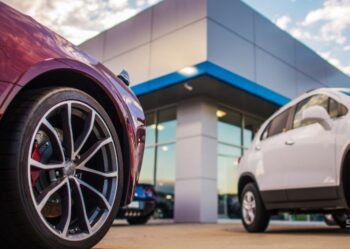How the Covid-19 outbreak is reshaping global automotive trends

Covid-19 pandemic has disrupted many industries. The automotive sector was hit especially hard with months-long closures of car assembly plants, interruption of international supply chains, stock overload at suppliers’ sites, and a complete halt of vehicle distribution.
To no one’s surprise, 2020 will mark a prolonged slump in car sales and production. Experts predict a sizable decrease of as much as 19 million cars or 21% in auto production compared to 2019. The industry is not expected to recover in the nearest 2 years.
However, the global health crisis will have an even bigger impact on the automotive industry in the long term.
As carmakers struggle with high fixed costs and minimal revenues, investment plans in global automotive trends such as electric mobility and autonomous driving are being revisited and sorely adjusted.
Moreover, with people shifting to private transport and online shopping to avoid getting infected, consumption and distribution models are changing too, starting new automotive trends.
Covid-19 boosts electric mobility
The post-lockdown research in China shows that people, especially young and urban dwellers, are concerned about using mass transit. To avoid getting infected, they now prefer to commute in private cars, bike, or simply walk.
In Europe, these new car buyers will likely consider zero and low-emissions vehicles pushed by tougher EU emission standards that took effect earlier this year.
As a matter of fact, despite the overall decline in passenger car registrations, the electrically-chargeable vehicle segment significantly increased its market share in the EU, rising to 6.8% (from 2.5% in Q1 2019) in the first quarter of 2020.
Furthermore, generous government incentives made it possible to purchase more expensive electric vehicles that were previously out of reach for many households.
Let’s look at an example. France has put in place a double bonus system available from June 1. This system allows a buyer turning in an older car for a new EV to get up to 12,000 euros reimbursed. Only in a month, France has reported a record high sales of electric and hybrid vehicles with a considerable +231% increase compared to June 2019.
According to the Head of advanced transport at BNEF (Bloomberg NEF) Colin McKerracher, “EV adoption is probably going to keep rising and not even dip”. However, the adoption rate will vary largely between different regions.
The BNEF report predicts electric passenger car sales will shrink in the USA to 1.7% in 2021. In the meantime, the sector will grow in China and Europe to 8.1% and 5% thanks to various financial stimulus and infrastructure spending.
About 450 new electric vehicle models will be launched worldwide before 2022. With the top ten markets for EV penetration being in Europe, no European OEM has so far changed its plans to roll out EV models.
The Covid-19 outbreak has not stopped Groupe PSA from launching Citroën Ami, a 100% electric license-free car. Overall, the group has introduced 13 new electrified models to the market in the first half of 2020.
The CEO of VW, Håkan Samuelsson, also believes that the pandemic will accelerate the shift to electric mobility. During the Financial Times global digital conference, he said: “I think it would be naive to believe after some months, everything will return to normal, and our customers will come back into a showroom asking for diesel cars. They will ask even more for electric cars”.
The pandemic will hurt autonomous driving (in the short-term)
Autonomous driving is one of the main automotive trends nowadays. All major carmakers and tech companies such as Alphabet Waymo and Uber Technologies have already invested billions in self-driving solutions.
Earlier in July, Elon Musk, CEO of Tesla, has declared that his company is “very close” to achieving Level 5 autonomous driving technology.
Nonetheless, many big automotive companies have decided to delay investments in self-driving technologies as the competition risks are low but the costs are high when compared to electric mobility.
“If you delay autonomous investments for Level 4 and Level 5 capability by six months, you have not lost the market, since this market will only emerge in 10 years,” states Chief Financial Officer of Continental Wolfgang Schaefer.
Start-ups and mid-size businesses specialised in self-driving technologies were not that lucky.
With zero or nearly zero revenue and unusually high operating costs ($1.6 million a month on average), autonomous vehicle start-ups struggled to stay afloat. Since the start of the Covid-19 outbreak, one autonomous car company has gone out of business, another is for sale, and four have laid off employees.
Those start-ups that have managed to survive had to delay their research by months because of supply-chain slowdowns and coronavirus prevention measures. Waymo has lost months of autonomous testing as a result of social-distancing rules that prohibit the usual two safety drivers.
Self-driving solutions are far too complex and costly to be used in private vehicles. That’s why a lot of businesses have shifted towards the development of robotaxis and other shared mobility options even before the pandemic.
However, as people now have elevated hygiene concerns, shared mobility doesn’t seem to be such an attractive option. AVs will likely turn to moving goods instead of people especially with surging demand for online shopping.
Indeed, the fear of human contact has helped autonomous delivery services flourish during the first months of the pandemic in China. Meituan’s contactless deliveries send robots to transfer groceries in Beijing. JD Logistics used robot couriers to deliver medical supplies to Wuhan Ninth Hospital.
Due to the technological complexity, enormous operating costs, testing limitations, and delayed investments, there won’t probably be any big breakthrough in autonomous driving in the next few years.
Emerging automotive trends brought by Covid-19
One of the least expected recent shifts in automotive is around dealerships. Online car sales that seemed to be so unrealistic just half a year ago are now booming.
With many dealerships staying closed or being limited in the number of visitors they can host, automakers are boosting their own e-commerce platforms. The most “internet-savvy” of them offer virtual car tours, online personalisation of vehicle equipment, and home or contactless deliveries.
Sales digitalisation is an emerging trend in automotive that can bring many benefits to carmakers. Among them is the simplification of the supply chain and, therefore, reduced costs. Moreover, moving consumer data into the hands of automakers can lead to more personalised offerings, innovations, and increased sales. Fortunately, there are lots of industries to learn e-commerce from.
Covid-19 is also reshaping how automotive operates.
Engineers and office workers are pushed to work from home. This not only better protects employees’ health but also reduces fixed costs related to office rentals and transportation.
Groupe PSA has recently presented its new principles of working methods allowing 80,000 of its 200,000 employees worldwide to work from home. Mercedes has ordered its US HQ staff to work from home until the end of the year.
Furthermore, production and assembly plants are reorganised to insure social distancing between the workers. New hygiene procedures are put in place allowing a regular equipment disinfection between shifts.
Such changes directly lead to productivity losses (around 12%) that may not seem to be significant today as demand is decreasing but may become a problem in a year or so.
Summary
The future is uncertain. Automotive businesses heavily impacted by the pandemic are slowly recovering yet hesitant to make any predictions.
Looking at the development of global automotive trends provides us with clues of where the industry is moving and reveals opportunities to invest in the right fields.








